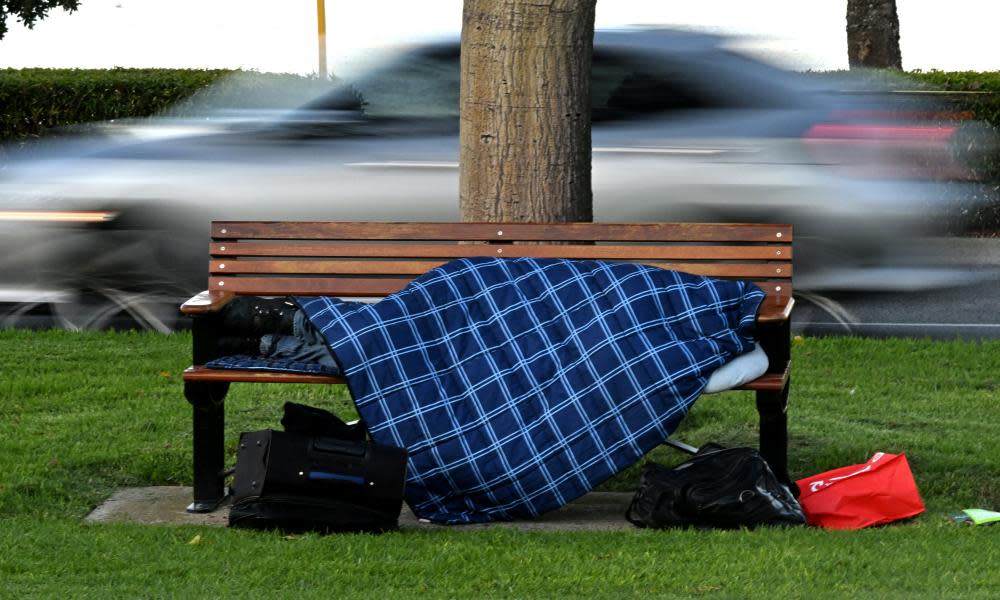Jump in homelessness as Australia’s rental crisis pushes ‘overwhelmed system to breaking point’

When Brooke escaped domestic violence in 2020, she didn’t expect her biggest problem would be finding secure housing for her and her three children.
Brooke has worked in disability and aged care for almost a decade, and never previously had a problem with rental security. But for two years she’s been in crisis accommodation in Melbourne, facing knock-back after knock-back for a permanent home.
“I’m actively looking all the time and it’s been impossible,” she said. “We just aren’t getting approval. I’m not going to be defeated by the process but it’s disheartening … just blow after blow.”
Peak bodies are calling for urgent investment in social housing as new research shows rental stress is the fastest growing cause of homelessness in Australia.
The latest Australian Homelessness Monitor, released on Monday, found in the past four years there was a 27% increase in people seeking help at homelessness services because they couldn’t afford rent.
Regional Australia was hit particularly hard, with homelessness surging by 13% since 2018-2019, more than double the rate of state capitals.
Western Australia and Queensland’s regional areas ballooned by 35% and 29% respectively, the report found.
At the same time, the homelessness rate has continued to outpace Australia’s rate of population growth.
The average monthly number of people using homelessness services increased by 8% to 91,300 over the past four years – double the growth rate of new households.
Maiy Azize, spokesperson at Everybody’s Home, said the federal government needed to commit to a long pipeline of social housing builds to address the widening gap.
The body has been lobbying for 25,000 social homes a year and more commonwealth rental assistance.
“There aren’t enough affordable homes, and millions of Australians are paying the price – including families, women fleeing domestic violence, and older people,” Azize said.
Azize said the long-term strategy of incentivising private investors to build affordable housing was “completely failing”.
‘Every year we fall further behind’
In the October budget, the federal government committed to a national housing accord that included the “aspirational” target to build 1m homes in five years, starting from 2024.
It included $350m for the construction of 10,000 affordable homes, while state and territory governments committed to building 10,000 in the five-year period.
Azize said it was a “drop in the ocean” compared to what was needed.
“We’re doing the same things again and again and they’re not working,” she said.
“We need to be getting on top of the enormous social housing shortfall of 500,000 homes. Every year we fall further behind, and in the short-term this problem is going to get worse.”
The report found First Nations Australians and people affected by mental health issues were the fastest growing cohorts among homelessness service users, increasing by 23% and 20% respectively.
Family violence remained the most frequently cited reason for people seeking specialist homelessness services.
Meanwhile the social housing shortfall was worsening. In the past three decades, lettings plunged by 42%.
Emma Greenhalgh, the chief executive of National Shelter, said the report reiterated it was “incredibly difficult” for single, low-income people to afford a private tenancy.
The latest annual rental affordability index found more than 40% of low-income households were now in rental stress and struggling to pay for food, heating and healthcare.
“Homelessness is not just public facing, it’s incredibly hidden,” Greenhalgh said.
“These are only the people who are seeking assistance, not those experiencing a housing crisis that may not have any touch point into the funded services system. It points to an urgency about what is needed.”
Greenhalgh said with no additional building commitment to come into effect until 2024, the government needed to prioritise increased rent assistance and income support.
Kate Colvin, Homelessness Australia’s chief executive, said women and children were being forced to make an “impossible choice” between violence and homelessness.
Related: The lush gullies hiding the hard truths of Queensland’s housing crisis
Colvin said the federal government’s new national housing and homelessness strategy and the upcoming plan to end violence against women and children were “ideal opportunities”, but the scale of ambition still needed to lift.
“Soothing rhetoric won’t cut it,” she said.
“Homelessness services are simply overwhelmed by demand. The rental housing crisis has pushed an already overwhelmed system to breaking point.
“Significant additional investment in homelessness services are needed just to keep up with demand, let alone find homes and support for people trying to escape dangerous situations.”

Launch Housing’s chief impact officer Laura Mahoney said while she was not surprised by the report, she was disheartened.
Launch Housing had experienced a 29% increase in demand for rental assistance and bond payments in the past 12 months, she said.
“People are being hit with notices to vacate, or being issued significant rent rises and forced to move out of their homes.
“Vacancy rates are very low, and annual private rents are running at 1.5 times the rate of consumer prices.
“We need to consider prevention measures for at-risk cohorts.”
Cassandra Goldie, chief executive of the Australian Council of Social Service, said the findings were more “evidence that we are in a deep housing crisis”.
“We need to build more social housing, and we also need to increase incomes for people with the least,” she said.
Acoss is lobbying for a 50% increase to commonwealth rent assistance and an income support boost to at least $73 a day.

 Yahoo Movies
Yahoo Movies 
